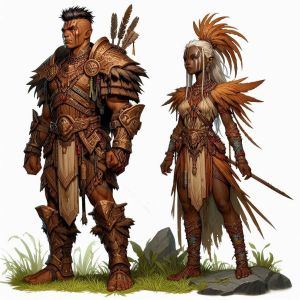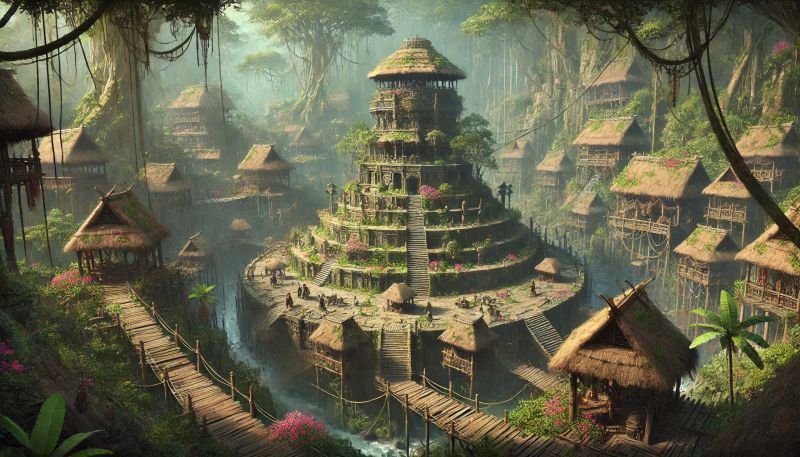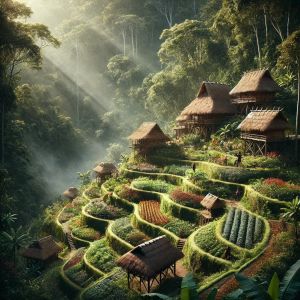Thundarites: Difference between revisions
| Line 30: | Line 30: | ||
== Economy == | == Economy == | ||
[[File:IMG000027 - Thundarite Farm.jpg|thumb|left|300px|A thundarite farm]]The Thundarites' economy is as deeply rooted in their connection to nature as every other aspect of their culture. Predominantly self-sufficient, their communities rely on the abundant resources provided by the jungles of Thundarum. Hunting, fishing, and foraging are fundamental to their daily sustenance, with a keen emphasis on sustainable practices that ensure the continued prosperity of their environment. | |||
Agriculture plays a vital role in their economy, with the Thundarites cultivating a variety of crops suited to the jungle climate. They practice sophisticated methods of permaculture, integrating their farming techniques seamlessly with the natural flora. This ensures that their agricultural activities support rather than deplete the biodiversity around them. | |||
Trade among Thundarite communities, though infrequent due to their reclusive nature, is facilitated by a network of jungle paths and river routes. Barter is the predominant form of exchange, with goods such as woven textiles, crafted tools, medicinal herbs, and rare jungle fruits being common commodities. Thundarite craftsmanship, particularly in woodwork and stone carving, is highly valued, with items often sought after by other races and distant lands. | |||
While outsiders are not a frequent presence, those who earn the trust of the Thundarites can engage in trade. Respectful traders can find themselves privy to the Thundarites' unique goods, such as their renowned herbal remedies, intricate jewelry, and finely crafted weapons. However, the Thundarites are discerning in their dealings, ensuring that trade relationships are built on mutual respect and fair exchange. | |||
Resource management within Thundarite communities is guided by a strong communal ethos. Surpluses are shared, ensuring that no member of the community goes without. This communal approach extends to labor, with tasks distributed according to skill and need, fostering a sense of unity and collective responsibility. | |||
In times of need or crisis, Thundarite communities come together, pooling resources and efforts to support one another. This resilience and adaptability have allowed them to thrive in the challenging environment of the Thundarum jungles, maintaining a stable and harmonious economy that reflects their deep bond with nature. | |||
Overall, the Thundarites' economy is a reflection of their core values: sustainability, community, and respect for the natural world. It is an economy that thrives not through exploitation, but through careful stewardship of their rich, verdant homeland. | |||
== Arts and Culture == | == Arts and Culture == | ||
== Education == | == Education == | ||
Revision as of 00:20, 31 July 2024

The Thundarites, known to themselves as Vadunlūn—a term that translates closely to "Riverfolk"—are an elusive and enigmatic human subrace that trace their origins to the continent of Thundarum. Inhabiting primarily the central regions of this vast landmass, they have made their home amidst the dense, vibrant jungles that dominate the landscape.
The Thundarites are a society shrouded in mystery, their ways and traditions guarded fiercely against outside influence. Their deep connection to the rivers and lush foliage of their homeland shapes every aspect of their existence, from their unique customs to their close-knit communities.
Despite their inclination towards seclusion, not all Thundarites remain hidden in the heart of Thundarum. Driven by a thirst for knowledge and a desire to share their rich culture with the wider world, some Thundarites have embarked on journeys far beyond their jungle home. These intrepid explorers venture into distant lands, carrying with them tales of their people's heritage and the secrets of the Thundarum jungles. Through these wanderers, the broader world catches glimpses of the Vadunlūn’s intricate society and their profound bond with the natural world.
Description
Thundarites are notably shorter than their counterparts among other human subraces. Their lean, wiry frames, while sacrificing some raw strength, bestow upon them a remarkable agility. This physical trait is invaluable, allowing them to navigate the dense and tangled jungles of Thundarum with ease and grace.
Their skin tones mirror the deep, rich hues of the jungle itself, ranging from light brown to the darkest ebony. This natural camouflage aids in their elusive lifestyle. Most Thundarites have hair as black as the midnight sky, though variations exist—some have brown or even blonde hair. A rare and striking variation sees individuals with hair of two colors, predominantly black with streaks of brown or blonde woven through. This hair can vary in texture from straight to curly to kinky, reflecting the diverse beauty of their people.
Their eyes, windows to their enigmatic souls, come in shades of brown and green, with the occasional and mesmerizing purple. These vibrant eyes often seem to reflect the verdant canopy and the rich flora of their homeland, adding to the mystique that surrounds the Thundarites.
What the Legends Say
This section is in a state of significant expansion or restructuring We hope we can have this content ready soon. |
Society

The Thundarites possess a deep, almost spiritual connection to the natural world that surrounds them, but also with their own communities. These, scattered across the verdant expanse of Thundarum's jungles, are notably reclusive. Even from each other, they tend to remain isolated, leading to settlements that are small and close-knit. This seclusion fosters a sense of unity and intimacy within each community, where every member plays a crucial role.
Outsiders who venture into Thundarite territory are met with a mix of wary curiosity and cautious hospitality. While they are welcomed, they are also observed closely. The Thundarites value respect above all, and those who honor their customs and traditions often find themselves forming deep, lasting bonds with these enigmatic people. However, any sign of disrespect can swiftly turn their hospitality into hostility, resulting in the immediate expulsion of the offending party.
The Thundarites' reverence for nature is evident in every aspect of their lives, especially in their architecture. Their settlements are masterfully integrated into the natural landscape, causing minimal disruption to the environment. Whether it's a small village or one of the rare, larger cities, each structure is built to complement the surrounding jungle, using materials readily available, such as stone and wood.
At first glance, Thundarite constructions might seem primitive, but a closer look reveals the intricate craftsmanship and architectural ingenuity. Every building, bridge, and pathway is a testament to their deep understanding of both materials and the environment. These structures are not only functional but also aesthetically pleasing, blending seamlessly with the natural world.
The Thundarites' ability to harmonize their way of life with the jungle that surrounds them is a testament to their respect for nature and their architectural prowess. Their homes, like their hearts, are deeply intertwined with the land, reflecting a profound symbiosis that defines the essence of the Vadunlūn.
Economy

The Thundarites' economy is as deeply rooted in their connection to nature as every other aspect of their culture. Predominantly self-sufficient, their communities rely on the abundant resources provided by the jungles of Thundarum. Hunting, fishing, and foraging are fundamental to their daily sustenance, with a keen emphasis on sustainable practices that ensure the continued prosperity of their environment.
Agriculture plays a vital role in their economy, with the Thundarites cultivating a variety of crops suited to the jungle climate. They practice sophisticated methods of permaculture, integrating their farming techniques seamlessly with the natural flora. This ensures that their agricultural activities support rather than deplete the biodiversity around them.
Trade among Thundarite communities, though infrequent due to their reclusive nature, is facilitated by a network of jungle paths and river routes. Barter is the predominant form of exchange, with goods such as woven textiles, crafted tools, medicinal herbs, and rare jungle fruits being common commodities. Thundarite craftsmanship, particularly in woodwork and stone carving, is highly valued, with items often sought after by other races and distant lands.
While outsiders are not a frequent presence, those who earn the trust of the Thundarites can engage in trade. Respectful traders can find themselves privy to the Thundarites' unique goods, such as their renowned herbal remedies, intricate jewelry, and finely crafted weapons. However, the Thundarites are discerning in their dealings, ensuring that trade relationships are built on mutual respect and fair exchange.
Resource management within Thundarite communities is guided by a strong communal ethos. Surpluses are shared, ensuring that no member of the community goes without. This communal approach extends to labor, with tasks distributed according to skill and need, fostering a sense of unity and collective responsibility.
In times of need or crisis, Thundarite communities come together, pooling resources and efforts to support one another. This resilience and adaptability have allowed them to thrive in the challenging environment of the Thundarum jungles, maintaining a stable and harmonious economy that reflects their deep bond with nature.
Overall, the Thundarites' economy is a reflection of their core values: sustainability, community, and respect for the natural world. It is an economy that thrives not through exploitation, but through careful stewardship of their rich, verdant homeland.
